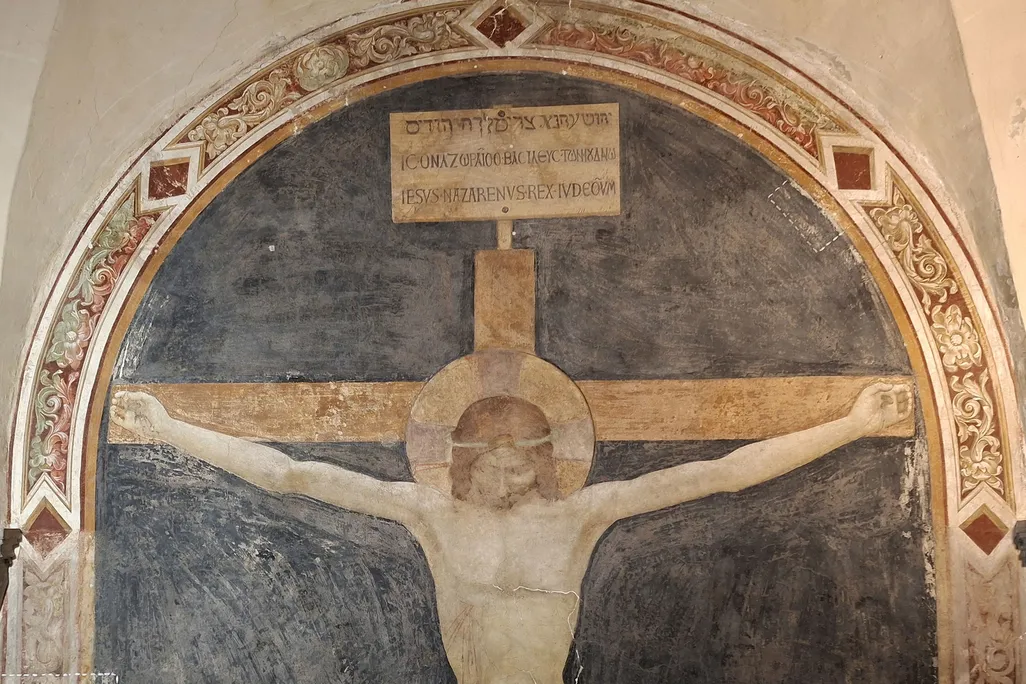A Rare Renaissance Fresco That Could Be One of Fra Angelico’s Earliest Works Has Been Restored to Its Former Glory
Located in a secluded convent outside of Florence, the 600-year-old artwork was concealed behind layers of paint for most of its history

A rare 600-year-old fresco by the Renaissance master Fra Angelico, considered to be one of the painter’s earliest works, has been painstakingly restored after centuries of neglect.
The painting, called Crucifixion, depicts Jesus on the cross against a navy blue background. It’s located in the chapter house of the cloistered Convent of San Domenico, in the quiet hilltop town of Fiesole, some four miles northeast of Florence.
Quick fact: What are Fra Angelico’s most famous paintings?
Some of the Renaissance master’s best-known works include The Annunciation (1442-43) and The Coronation of the Virgin (1434-35).
The piece was painted around 1420, when Fra Angelico was in his 20s, and it may be one of the artist’s first works. Hidden behind layers of paint for centuries, it’s now been returned to its original splendor thanks to the efforts of Friends of Florence, an American nonprofit, and Bottega Belacqua, a trio of American and Italian doctors with a passion for Renaissance art.
“I didn’t know about this particular fresco,” Cristiana Conti, one of the restorers, tells the National Catholic Register’s Solène Tadié. “It is hidden inside the convent, making it relatively unknown to the public. Art historians have certainly studied it, but for me, it was a discovery—and a pleasant surprise.”
Born Guido di Pietro in the Tuscan hamlet of Rupecanina, Fra Angelico was a Dominican friar and one of the most celebrated painters of the 15th century. Also known as the “Angelic Painter,” he helped transform Italian art, bridging the medieval Gothic style with the emerging Renaissance one. His work is renowned for its use of linear perspective alongside rich colors and a strong spiritual message.
He entered the Convent of San Domenico in roughly 1420, around the same time he painted the Crucifixion, before transferring to the Convent of San Marco in Florence in 1436. Around 1446, he left for Rome at the behest of Pope Eugene IV before eventually returning to Fiesole in 1450 to become the convent’s prior.
/https://tf-cmsv2-smithsonianmag-media.s3.amazonaws.com/filer_public/bb/7e/bb7ebc6a-8520-4a5f-a7be-8096c157b811/fra-angelico-restored.jpg)
The Renaissance master’s career prior to his time at San Marco is not as well-documented as the rest of his life. Experts say it’s rare to find works of his predating the 1430s, which is why the Fiesole Crucifixion may be the artist’s earliest-known work, according to Artnet’s Jo Lawson-Tancred.
In 1566, the wall of the San Domenico Convent’s chapter house, including the fresco, was whitewashed. While the exact reasoning is not clear, it “may have been for hygienic reasons, maybe there was a pestilence or it was just considered old-fashioned,” Alessandra Popple, another restorer who worked on the Crucifixion, tells Artnet. This concealment, coupled with the convent’s secluded location, is likely why the fresco has been neglected for so many centuries.
The artwork was rediscovered in 1881 by the convent’s prior, who decided to remove the whitewash himself. Lacking the proper skills to do so, the fresco was damaged, as Elisabetta Povoledo reports for the New York Times. Further restorations in the 1950s revealed that factors like humidity, water infiltration and previously botched restoration attempts had caused extensive damage to the artwork.
Last year, Bottega Belacqua turned to Friends of Florence, a nonprofit group dedicated to preserving the city’s cultural integrity, for help in funding a team of Italian restorers. The restorers cleaned the fresco with water, reinforced the plaster and refreshed the artwork with minimal retouching. “There’s something about working on frescoes, because you experience the same things that the artist experienced, the atmosphere is the same,” Popple tells the Times. “It’s a moving experience.”
The restored fresco’s debut coincides with a Fra Angelico exhibition that will take place at the Palazzo Strozzi and Museo di San Marco in Florence in September. It’s the first in 70 years that the city will host a large-scale exhibition dedicated to the Renaissance master.
“You can tell right away that it’s a major masterpiece by Fra Angelico,” Carl Strehlke, curator of the Fra Angelico exhibition, tells the Times. “So it’s a really new discovery, in a funny way. Even though we always knew it was there, no one really looked at it.”
“Fra Angelico” will be on view at Palazzo Strozzi and Museo di San Marco in Florence from September 26, 2025, to January 25, 2026.
/https://tf-cmsv2-smithsonianmag-media.s3.amazonaws.com/accounts/headshot/asia.png)
